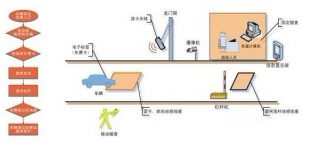
Road and bridge UHF electronic toll management application case
[ad_1]
System composition
The system includes automobile electronic identification reading and writing system, lane control equipment, monitoring computer, and toll network system.
work process
When the vehicle passes the road and bridge lane and enters the communication area of the lane antenna, the electronic tag installed in the vehicle immediately sends vehicle information, driving record information and other information to the lane antenna. After the lane antenna receives the information, the information is transmitted to the transaction controller through the transaction controller. The lane control machine, after the information is processed by the lane control machine, the current driving record and other information are transmitted to the lane antenna in the reverse direction, and finally the electronic tag of the vehicle is written.
In this way, each toll station can calculate the toll receivable by obtaining the driving record of the vehicle, and then deduct the account from the bank account opened by the owner of the vehicle through the toll network to realize automatic charging.

System advantages
Long-distance reading, high-speed acquisition of vehicle electronic tag information, the accuracy rate is not less than 99.7%;
Innovative technology, comprehensively and effectively solve the interference problem of adjacent vehicles;
24 hours uninterrupted work without supervision;
The vehicle label has a unique anti-dismantling function, and can also be used in conjunction with an electronic license plate to ensure “one car, one card”;
Improved toll processing capacity and lane traffic rate, avoiding traffic congestion;
Automatic management around the clock, adapt to all kinds of bad weather.
5. System implementation benefits
First of all, the application of the road and bridge electronic toll management system can allow vehicles to pass through at high speed (the speed is kept at tens of kilometers per hour), which can greatly improve the traffic capacity of the road; at the same time, the electronic toll collection of roads can reduce the cost of toll management, which is beneficial to Improve the operating efficiency of vehicles, and can greatly reduce the noise level and exhaust emissions of toll gates. As the traffic capacity has been greatly improved, the scale of toll stations can be reduced, and infrastructure and management costs can be saved.
Secondly, the implementation of the project has established a basic platform for car-related RFID management: (1) All units and public parking lots can easily implement parking fee management; (2) The transportation department can implement blue-plate car inspections, vehicle anti-theft, and looting. Traffic flow monitoring, etc.
In addition, the electronic toll collection system is not only an advanced toll technology for cities, it is also a practical and effective traffic management method that regulates traffic flow through economic levers. For sections such as bridges and tunnels with heavy traffic, the non-stop toll collection system can avoid the many weaknesses of the monthly ticket system and manual toll collection, and effectively improve the fund recovery capacity of these municipal facilities.
[ad_2]



